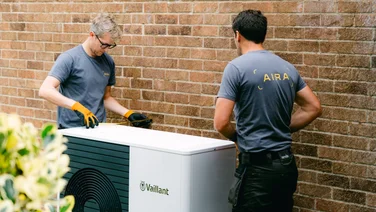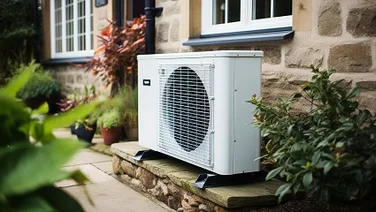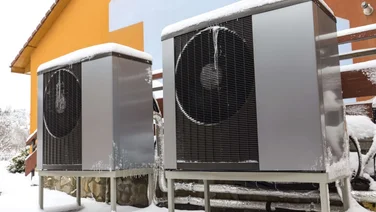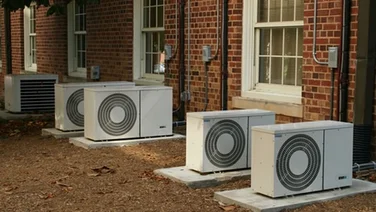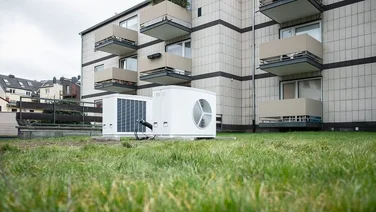- Ground source heat pumps can deliver around 4 times more energy than they use
- They are better suited to larger properties with a constant heat requirement
- They may require an area of ground that’s double the floor area of your home
A ground source heat pump can be a very efficient heat source for your home, but it is not a simple swap for an existing boiler. There is a large area of ground that needs to be excavated, and the unit also takes up quite a bit of space inside your home – not to mention ground-source heat pumps cost much more than a boiler.
In a new build home, this could be a simple design exercise but in an existing home, the disruption could be enormous.
Here, we explain what is involved in specifying and installing a ground source heat pump in your home.
If you think an air source heat pump might be a better option for your home, we can help you find the perfect system. All you have to do is provide a few quick details in our easy-to-navigate tool, and our expert installers will be in touch with free quotes for you to compare.
What type of central heating do you currently use?
Get started
What is a ground source heat pump?
It’s simple: a ground source heat pump gets its heat from the ground and an air source heat pump gets its heat from the ambient air.
A heat pump doesn’t burn anything to create heat – it simply moves heat from one place to another. It does use some electricity to move the heat, but this is the reason why it can be more than 100% efficient.
When heat pump efficiency is more than 100%, we no longer call it ‘efficiency’, but rather Coefficient of Performance (COP). Therefore, a 400% efficiency would be a COP of 4 (1 unit of electricity can deliver 4 units of heat).
How does a ground source heat pump work?
It’s exactly the same process that is in your fridge.
The heat pump works by absorbing heat from the ground and transferring this heat into a refrigerant liquid. This liquid is usually around -55°C, then once it’s heated to around -50°C it ‘boils’ and becomes a gas.
The gas is then compressed and the pressure significantly enhances its heat. This hot, high-pressure gas then passes through another heat exchanger where the heat is sent up to the water in the home heating circuit.
As the temperature is lowered, the refrigerant becomes a liquid again but it is still at high pressure. The pressure is then released and the temperature of the liquid plummets down to around -55°C again and the cycle repeats.
Not sure whether a ground source or an air source heat pump will be right for you? Our page on Air Source vs Ground Source Heat Pumps could guide you in the right direction.
How is a ground source heat pump installed?
Before you actually install the heat pump there are a few things that need to be planned and designed. You need to know the following details:
What is the heat loss of the building?
A room-by-room heat loss calculation is done to determine how much heat the building needs, and how that heat needs to be distributed in the building.
The installer, or their surveyor, will usually do the heat loss calculation as part of the installation service.
This full calculation is not usually done until there is a commitment from the customer.
If you want the calculation before you place the order for the heat pump, the installer may charge you a fee for this work, usually somewhere between £250 and £750. This is then deducted from the installation cost should you go ahead.
This calculation will then determine the heating capacity requirement of the heat pump unit.
Read our dedicated guide on the best heat pump installers to get started.
How much outside area do you have that can be dug up?
The installer, or their surveyor, will need to work out how much pipework needs to be laid in the ground around your property. This pipework is called the ‘ground loop’.
If you want your ground source heat pump to provide hot water as well as space heating then the ground loop needs to be around 30% bigger.
There are two different types of ground collectors: vertical borehole collectors and horizontal loop collectors.
The vertical borehole collectors are more expensive to install but do not need as much ground, as the pipes are placed in vertical boreholes. You will generically need around 10 metres (m) to 20m of borehole collector per kilowatt (kW) output of the heat pump – this means that an 8 kW heat pump would need between 80 and 160 metres of the collector.
The cost of boreholes (including a geologist report) is in the region of around £100 per metre. Loose soil or sandy conditions could add length and cost to these figures.
A horizontal ground loop is usually buried in the ground in trenches around 1.5 metres deep. In damp cohesive soil, you may expect to need around 50 square metres (m²) of ground per kW, so your 8 kW heat pump would need around 400m² of ground.
The pipes cannot be closer than a metre from your neighbour’s property, and you also need to avoid tree roots, buildings and any services such as water supplies or drainage as the ground loops could freeze them.
Pipes are either laid in straight runs 1m apart or as coils that look a bit like flat slinky springs.
Dry soil, shale or chalk conditions could need bigger collector areas.
It is always best to get the ground conditions confirmed by a competent installer before committing.
If you have stony ground then the pipes need to be protected by placing them in around 250mm of soft, sifted, soil.
Which is better: a horizontal collector or a vertical borehole collector?
A vertical borehole collector goes deeper into the ground where the temperatures are higher and more consistent. Therefore, the efficiency of a borehole collector can be better than a horizontal collector. If you have enough space then a horizontal collector will be less expensive to install.
How much space is available inside for all of the pipework, cylinders, controls, and machinery?
The actual ground source heat pump box is usually around the size of a fridge. Some are as big as a tall fridge and some are only as big as a counter-height fridge.
You will also need a hot water cylinder (again the size of a tall fridge) and possibly also another tank called a buffer tank (around the size of a small fridge).
There is also space required for connecting pipework, pumps, controls and the ground loop connections.
This is not just a piece of kit that will fit neatly in a kitchen cupboard or airing cupboard – you ideally need a purpose-built plant room or you will have to sacrifice some garage space.
Do I have the right size radiator?
Heat pumps operate optimally at temperatures up to around 40oC, which is a much lower flow temperature than traditional condensing boilers (70oC). What’s more, with a heat pump you also have a much lower temperature difference between the water going into the radiator and the water returning from the radiators, i.e. the heat given up to the room.
Condensing boiler central heating systems would normally have a 20oC temperature difference, but a heat pump is only 5oC. This effectively means that the radiators need to be oversized for the lower flow temperatures, and the pipe sizes need to be increased for the lower temperature difference. Alternatively, you can use increased surface area emitters such as underfloor heating.
The pipe routes need to be mapped to make sure that they are not piped ‘in series’ (known as a single pipe system), and that there are no restrictions or exposed areas with high heat loss due to low insulation.
In a new build, this is a simple design exercise and you may even choose to install appropriate underfloor heating, but in existing properties, the pipe and radiator changes can be very disruptive and may involve lifting floors, chasing walls or opening ceilings.
The hot water cylinder is also a heat-pump-specific product that has a larger heat exchanger coil than a traditional boiler cylinder.
You can learn about this more in our guide to heat pumps and radiators.
What type of central heating do you currently use?
Get startedCan you install a ground source heat pump on your own?
There are many parts of the installation of the ground source heat pump that you can do yourself if you have the relevant skills. Many homeowners dig their own trenches for the ground loop. It’s pretty simple: the installer tells you how much to dig and you dig it. Although clearly this requires a bit of experience with a digger or it may not work out so well.
Some of the plumbing works can be done by a homeowner with good DIY skills, but the pipe sizes and technical specifications must be supplied by a competent person.
The design and commissioning, as well as any regulated details, must be done by a competent and experienced person.
How much maintenance does a ground source heat pump need?
The maintenance requirements of a ground source heat pump are virtually the same as a regular heating system. All the internal pipework is very similar to a boiler central heating system – the only extra requirement is the monitoring of the pressure and flow temperatures in the ground loop.
Many companies offer annual service packages which are worth having to be sure your heating system is in optimal condition.
Want to compare this to air source heat pumps? Check out our guide on Air Source Heat Pumps: Maintenance Tips.

How long does a ground source heat pump installation take?
The groundworks part of the heat pump installation could take a few days depending on the ground conditions and the machinery used for the digging.
On a new build, you could potentially get your groundworker to excavate the trenches for the ground loop when they are doing the foundation and drainage works.
Internal works could take around one week, but in an existing building that very much depends on the amount of remedial work that is required (e.g. new radiators, different pipework).
The water will need to be disconnected for a while, but the installer should be able to let you know when this will be so that you can plan around it. If the heat pump cylinder is going in the same place as the original cylinder then you may be without hot water for a day or two while the system is being reconfigured.
The installer will also commission the system and may need to know lifestyle details from you so that they can schedule the system to heat the home and the hot water around your requirements.
The hot water can sometimes take a few hours to reheat and you would not want your home to cool down during this time.
The installer will also talk you through the controls and how to set the user-friendly bits, as well as when to call an installer if things are not as expected.
Next steps
If you are considering installing a ground source heat pump then contact a Micro Generation Certification Scheme (MCS) certified installer in your area who will come out to your property to assess the suitability of the installation and issue you with a quote for the scope of works.
This may include all aspects of the project or exclude things if you have elected to do certain works such as digging the trenches for the ground loop.
If you think an air source heat pump might be the right option for you, we can help you get started with the buying process with our custom-built tool. All you have to do is provide a few quick details, and we’ll put you in touch with our heat pump suppliers, who will send you free quotes.
FAQs
How much land do I need to install a ground source heat pump?
You usually need around 50 square meters of ground per kiloWatt capacity of the heat pump. For example, an 8kW heat pump will need 400 square meters of ground.
This may not mean much to the average homeowner, as the capacity changes according to the performance of the building and the ground conditions.
In simple terms, if you have a home that is generally in accordance with current building regulations then you may expect the ground loop to be around twice the area of the floor of your home.
Can you install a ground source heat pump yourself?
There are many parts of the installation of the ground source heat pump that you can do yourself if you have the relevant skills. Many homeowners dig their own trenches for the ground loop. The installer tells you how much to dig and you dig it. Clearly, this requires a bit of experience with a digger or it may not work out so well.
Some of the plumbing works can be done by a homeowner with good DIY skills but the pipe sizes and technical specifications must be supplied by a competent person.
The design and commissioning as well as any regulated details must be done by a competent and experienced person.
Do you need planning permission to install a ground source heat pump?
This is a difficult question as many heat pumps are installed under General Permitted Development Order and as such do not need planning permission. However, if you do not have permitted development rights on your property then you will need planning permission.
That said, the ground source heat pump ground loop is buried in the ground and in sensitive areas such as Conservation Areas and Areas of Outstanding Natural Beauty (AONB) you may need to consult with the local authority.


